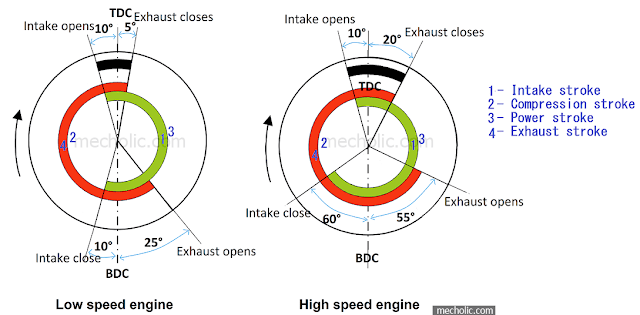Valve Timing Diagram Of Four Stroke Cycle Petrol Engine

🔗Working of four stroke spark ignition engine with PV diagram
🔗Port-timing diagram of two-stroke engine
What is meant by valve timing of engine?
Valve timing is the regulation put on the engine valves, how they set to open and close during working cycle. The diagram shows the timing of opening and closing of intake and exhaust valve during one complete cycle of four strokes. The valve timing is one of the important factors that affect the volumetric efficiency of the engine. Both intake and exhaust valves are precisely timed to give a most satisfactory result for normal operating conditions. The valve operating cams provides the opening and closing movement of valve. The specially designed cam setting determine and control the timing of valve.
For smooth operation of the valve, a finite period of time is required to proper opening, closing of the valve, this slight time is known as lead time. [What is known as lead time in valve timing?]. The figure shows the valve timing of four-stroke spark ignition engine for both low speed and high speed.
The angles mentioned slightly vary with the different design of engine.
Intake valve timing
Theoretically, the intake valve should open at TDC (Top Dead Centre). However, in almost all SI engine the intake valve opens few degrees before the TDC to ensure the valve fully open, flow fresh charge to the cylinder as piston reaches the TDC. The intake valve opens 10° before TDC for both low-speed engine and high-speed engine. As piston moves away from the cylinder head, the engine draws fresh charge into cylinder.
When the piston reaches the BDC (Bottom Dead Centre) and ascent again during the compression stroke, the inertia of the flowing air-fuel mixture tends to continue the flow of charge into the cylinder. The inertia tends to keep open the intake valve for a short period. If intake valve keeps open much beyond the BDC, the compression stroke force out some fresh charge with consequent of reduction in volumetric efficiency. Hence the intake valve should close relatively early after it reaches the BDC. For low-speed engine the inertia of flowing charge is also low, and intake valve close 10° after BDC. For high-speed engine, the intake charge has higher inertia, it causes a "ram" effect as piston moving up during the compression stroke. The ram effect tends to pack more fresh charge into the cylinder. In order to take advantage of ram effect the closing of intake valve delayed in high-speed engine. For high-speed engine, intake valve close 60° after BDC. If the revolution of high-speed engine goes beyond its operating range, the flow of charge may get choked due to friction. This loss may become greater than the benefits of ram effect, and the charge per cylinder per cycle falls off.
🔗Variable valve timing VVT of internal combustion engine - Advantages
Exhaust valve timing
The exhaust valve is usually open before piston reaches the BDC (during expansion stroke). This reduces the work done, but decrease the work required to expel the burned gas during the exhaust stroke, the result will be an overall gain in output. For low-speed engine exhaust valve open 25° before BDC, while for high-speed engine it opens 55° before piston reaches BDC.
The exhaust valve is set to close some time (degree °) after the piston reaches the TDC, so that the inertia of exhaust gas tends to give better scavenging by carrying out the burned product left in the clearance volume. For low-speed engine exhaust valve close 5° after TDC and for high-speed engine it close 20° after TDC.
The opening and closing of intake and exhaust valve may get overlapped during the operation. This overlap should not be excessive enough to fresh charge expelled through the exhaust valve or the burned gas product sucked into the cylinder during intake stroke.
Source: https://www.mecholic.com/2018/12/valve-timing-diagram-otto-engine.html
Posted by: fideliafideliawoowarde0272615.blogspot.com
Post a Comment for "Valve Timing Diagram Of Four Stroke Cycle Petrol Engine"